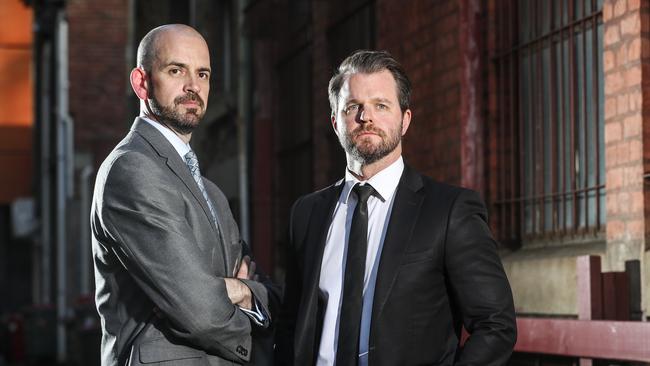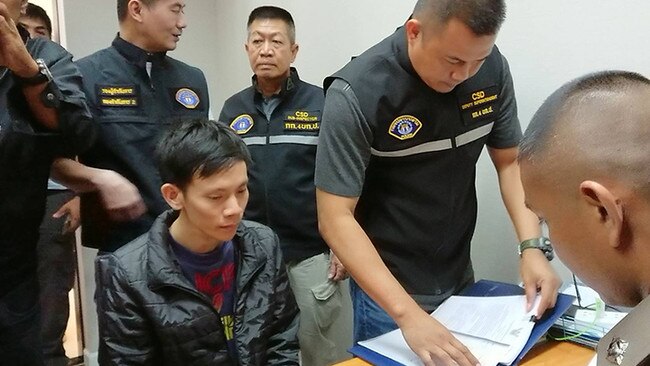He had marked each and every day of his life, for six years, with either a photograph or a video of a child.
In total, sex predator Ruecha Tokputza had filled his digital devices with close to 900,000 images of innocent boys in Australia and Thailand.
It was a massive pile of potential evidence and, while not every image depicted abuse, Detective Brevet Sergeant Stephen Hegarty needed to check them all.
“He’d start with a lot of non-illicit photos, the sort that would be visible on his Facebook but, as it went on, you’d quickly see the dark side of that social media account,” Hegarty recalls.
“So I couldn’t dismiss a single image because I didn’t know whether, in another quarter of a million files, I’d see a child from one of those innocuous images being abused.”
Those terabytes of data revealed more than just Tokputza’s style of offending – they laid bare his sick mentality.
“He became quite obsessed with his victims… it was almost like there was a shrine to each child,” Hegarty says.
“This was not someone who cared for children, this was an obsessive collector of children – to him, they were trophies.”
BLACKWRIST
The world now knows Tokputza, 31, of Mile End, as the single worst child sex offender in Australian history.
He abused 13 children, some as young as 15 months’ old, in two countries while committing just about every sex crime recognised by law.
Tokputza’s offending, the District Court ruled, was “beyond comparison” with any prior case, resulting in a record 40-year prison term.
But when SA’s Joint Anti Child Exploitation Team (JACET) was first alerted to Tokputza, he was not a target – merely a piece of a much larger, global puzzle.
In November 2017, Hegarty and his partners – Federal Agents Danielle Leske and Jonathon Coats – were contacted by Interpol.
“They had been working with the Department of Special Investigations in Thailand for 11 months,” Coats says.
“They were trying to identify victims in a series of child exploitation videos that had been codenamed ‘Blackwrist’.
“With the assistance of Homeland Security Investigations in the US, they’d identified a couple of IP addresses that helped create, and had administrator access to, a subscription server based in Bulgaria.
“One was in Thailand, the other was in Adelaide.”

The server powered a dark web child exploitation website with 63,000 subscribers around the world.
It had to be taken down, and so officers in multiple countries worked together to devise a plan of attack.
Interpol and Thai detectives would move on the Asian IP address, while Europol and Bulgarian authorities would seize the server.
JACET, meanwhile, would hunt down the Adelaide connection in a separate operation was codenamed “Bayldon”.
The catch was no one agency could act alone – the operation had to be perfectly synchronised for the sake of the children depicted.
“The core purpose of what we do is victim identification,” Hegarty explains.
“People need to remember that child exploitation is not a victimless crime – these are real kids we’re talking about.
“Getting someone convicted is second to our main priority, which is identifying children who are in the worst possible scenarios and figuring out how to rescue them.
“We didn’t want to do anything that would mean those children would disappear before we could find them.”
KNIFE’S EDGE
Covert surveillance began across three countries and, as the festive season approached, the plan solidified.
At one stage, it looked like the simultaneous raids would happen on Christmas Eve – later, on Christmas Day.
“It was like living on the knife’s edge for a couple of months but we were more than prepared to come in on either day,” Hegarty remembers.
“This is not a role for everyone… we have certain skill sets that make us able to deal with it better than some.
“Having a purpose, that core focus, helps… if you did this job without any children being rescued, I wouldn’t recommend it to anyone.”
Recognising those wins is important – to keep despair at bay, JACET maintains a “rescue wall” with a small cartoon of a smiling child for each successful rescue.

“Knowing children have been saved is why I do my job, ultimately… it’s the thing that gives me motivation when I’m having a bad Monday morning,” Hegarty says.
In early January 2018, the teams agreed it was time to move.
“It was all prearranged, we had everyone standing by here and in Thailand,” Leske says.
“At that time, Tokputza was a tool to us more than he was a suspect – he was an IP address, a Gmail account – so we were hoping to get good evidence.”
The real concern, Coats says, was not getting to Tokputza fast enough.
“We just wanted to make sure we were covering off on him not being able to talk to any of his co-offenders,” he says.
“We didn’t want him to be able to alert anyone who could take any action that would prevent the children being rescued.
“It was quite nerve-wracking.”
Finally, the go-ahead came – only to be immediately rescinded for the most unexpected of reasons.
“We got a call from the Thai team saying we had to hold off, because they had gotten stuck on the road behind a herd of elephants,” Hegarty laughs.
THE PHONE
Two hours later – once the pachyderms had moved on – JACET moved in.
They found Tokputza in his bedroom and, for the next three hours, Leske and Hegarty grilled him about the server.
“Danielle’s questioning was relentless but Tokputza’s demeanour never changed,” Hegarty says.
“It didn’t matter how the question was phrased, his response was minimalistic.
“He was a difficult person to deal with due to that demeanour… offenders usually give you something, even if it’s false, but he didn’t even try.”
As his colleagues were being stonewalled, Coats searched the computers – unsurprisingly, he found numerous downloads from the Bulgarian server.
Then he turned on Tokpuzta’s mobile phone.
“We discovered a whole score of child exploitation material that contained Tokputza himself,” Coats recalls.
“He was in the images, in the videos – and his victim was a child we’d never seen before.
“This was all material that had not been recovered from the Bulgarian server.”
Scrolling through the images, Coats made an even more horrifying discovery.

“It appeared that the abuse had taken place in the very premises we were currently in,” he says.
“In fact, the offences had occurred in the very bedroom where he was being interviewed by my colleagues.”
Coats stepped into the bedroom and confronted Tokputza with the phone.
“The game had changed,” he says.
Leske and Hegarty, hours deep into their interrogation, were caught off-guard.
“We had to regroup – the focus changed to ‘who is this child, where is this child’ – and Tokputza was still calm, so phenomenally calm,” Hegarty says.
“He simply admitted, with no detail, that we’d find material relating to him.”
Under renewed questioning, Tokpuzta gave up the child’s identity and calls were made to commence immediate rescue operations.
“He wasn’t being a saint, he had to give it up,” Coats says.
“But this was just the start… this investigation was like Pandora’s Box.”
PURE SOCIOPATH
Over the months that followed, Hegarty analysed the 900,000 images and videos, identified Tokputza’s victims and organised rescue missions.
“There was one video that was less than 10 seconds in length… those seconds were enough,” he says.
“It was clear he had committed every crime that you could with a child.
“But you have to keep going, and watch the next video, to make sure you’re not missing anything because it could make all the difference to a child.”
Leske had to reckon with hundreds of thousands of chat logs from a messaging app – not only encrypted, but also in Thai – to unmask his co-offenders.
That led to Suthipong Saleesongsom, aka “Pack”, a Thai man who was Tokpuzta’s long-time boyfriend.
They had abused many of the same children, both alone and together, between Saleesongsom’s shifts as a nursery school teacher.
Hegarty would find countless images of Saleesongsom in Tokpuzta’s files.
“They would hold a child up for a photo, almost like you would a hunting trophy, while they took selfies,” he says.
“A couple of thousand photos later, you would see that same child being abused… that was the consistent pattern across the material.”
Leske says the mood within JACET was grim.
“Every couple of days, Stephen would come into the office and say ‘I’ve found another one’… the number of victims was just going up and up,” she says.
While all three officers are decade-long veterans of such investigations, Coats says every day was confronting.
Tokputza’s appetite had been so voracious that he’d even filmed boys in the change rooms of an Adelaide swimming pool.
“You could actually plot Tokputza’s travel movements according to the trail of his molestation,” he said.
Hegarty – who previously investigated Families SA sex predator Shannon McCoole – says Tokputza was single-minded in his offending.
“Everywhere he goes there’s a path of destruction, and he doesn’t even pause for breath,” he says.
“It almost seemed to rule his life, like everything else was secondary to relentless molestation.”
Tokputza would be interviewed repeatedly, without so much as a flicker in his apathetic demeanour.
“That never changed in any of my dealings with him, from day one to the day he was sentenced – never,” Hegarty says.
“I needed a break from him, sometimes, because he has no emotional connection, no empathy.
“He’s a pure sociopath as far as I’m concerned.”
GLOBAL IMPACT
All of JACET’s work on “Bayldon” fed back into “Blackwrist”, cracking the international investigation wide open.
Tokpuzta’s files provided essential identification “keys” to photos on the server, allowing authorities to arrest a further nine predators.
New Zealand’s Department of Internal Affairs fed the data trove into its computers for “deconflicting”, sorting known offenders from new targets.
Rescue teams pulled 50 children from horrific situations, and are moving closer toward saving a further 100 in the weeks to come.
Investigations continue in 60 countries, and Interpol Secretary-General Jurgen Stock believes the evidence will fuel arrests and rescues for years.
Saleesongsom was sentenced to 35 years, which he will serve in a Thai jail – his arrest photo is Hegarty’s desktop wallpaper.
The website’s owner, Montri Salangam, was found to be involved in human trafficking as well.

He will share Saleesonsom’s accommodations, but his sentence is 146 years.
Ironically, Tokputza was never charged with the offence that initially led JACET to his door.
“He knew of the website and he knew of the people involved, which he admitted after a lot of questioning,” Leske says.
“But he had no real title or role in it… it might have just been a hobby, he was never an administrator.”
The global success of “Blackwrist” and “Bayldon” smashed a child exploitation ring and put predators worldwide on notice.
While they are satisfied with, and deservingly proud of, their efforts, JACET has barely paused to celebrate.
Aside from “a few beers”, their focus is on the next predator, the next case, the next child in need of rescue.
All the while, the three veterans share a single nagging fear.
“I feel like, and this is a dreadful feeling, we’ve only brought Tokputza to task for the tip of the iceberg of his offending,” Coats says.
“And I’m worried that we’ll never know whether that’s the case.”


Add your comment to this story
To join the conversation, please log in. Don't have an account? Register
Join the conversation, you are commenting as Logout
‘I miss being able to talk to them’: Tribute for slain Aussie brothers
A tribute has been unveiled where Australian brothers Jake and Callum Robinson and their American friend were murdered during a surf trip.
Melb private schoolboy’s stunning Russian mafia admission
An investigation into former Melbourne private schoolboy Damien Carew has taken a dramatic turn after his latest police confession.